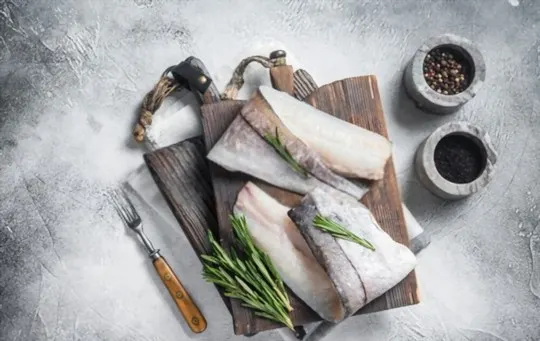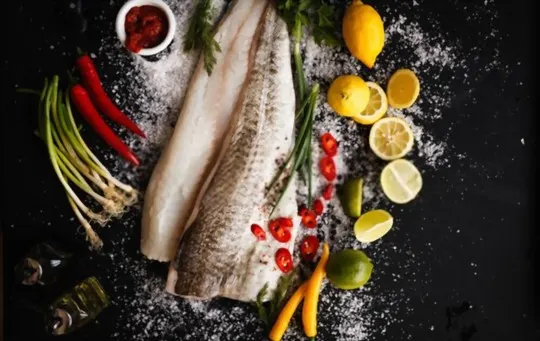Do you consider yourself a bit of an adventurous eater?
Have you ever encountered the fish known as hake, and wondered “but what does it taste like?”
Whether it’s your first time considering trying this unusual seafood option or you’ve been curious about it for a while, this comprehensive guide to hake will help satisfy any nagging curiosity.
Taking a deep dive into all things hake-related, we’ll cover everything from its culinary profile and flavor description to how best one can prepare and serve this unique fish dish.
So come with us on our journey of discovery as we explore the subtle nuances that make up the amazing undersea world of hake!
What is Hake?

Hake is a type of fish that belongs to the cod family, found mainly in the Pacific and Atlantic Oceans.
It is commonly consumed in countries like Spain, Portugal, and other European countries.
Hake can grow up to six feet long and weigh up to 70 pounds.
Although it is not as popular as cod or salmon, hake has become more common in recent years due to its mild flavor and versatility in cooking.
Hake is a nutritious fish that provides essential vitamins and minerals like omega-3 fatty acids, vitamin B12, selenium, phosphorus, and magnesium.
These nutrients are essential for maintaining healthy brain function, reducing inflammation in the body, supporting immune system health, promoting healthy bones, and teeth.
Hake is often compared to cod because they belong to the same family of fish; however, hake has a milder flavor than cod.
It also has a more delicate texture than cod which tends to be denser in texture.
Hake is an excellent choice for those who want to add some variety to their diet without compromising on taste.
What Does Hake Taste Like?

Hake has a mild and slightly sweet taste, with a firm yet tender texture.
Its flavor can be compared to that of cod or haddock, but with a more delicate profile.
Hake’s white flesh is lean and flaky, making it an excellent option for various cooking methods.
When cooked, hake maintains its shape well and doesn’t fall apart easily.
It also absorbs flavors well, making it versatile when it comes to seasoning and marinades.
However, overcooking can cause the fish to become dry and lose its delicate taste and texture.
Due to its mild taste, hake pairs well with a wide range of seasonings and sauces, from classic lemon butter to bold spices like paprika or cumin.
Whether grilled, baked, fried or sauteed, this versatile fish is an excellent addition to any recipe that calls for white fish.
In addition to its culinary versatility, hake is also a healthy choice for protein intake as it is low in fat and high in omega-3 fatty acids.
It is also a sustainable seafood option that is readily available in many parts of the world.
Factors that Affect the Taste of Hake
It is crucial to note that several things influence how your hake tastes like; hence understanding these factors would help inform your choice of preparation methods and seasoning combinations best suited for the particular kind of new seafood before you cook with it.
Cooking freshly caught or purchased fish enhances its natural flavors while preserving nutrients and nutritional value critical for human sustainability; this means careful consideration should be given to the selection process as every factor counts towards making delightful meals.
Also, when all these pointers are put in place, every mouthful of fish should be memorable and worthwhile, meaning that you can enjoy your hake differently by cooking it in a different way or with different seasonings and sides.
Hake is a versatile fish that can be cooked in various ways.
The taste of hake depends on several factors, including the species, the location where it was caught, and its age.
Here are some other factors that can affect the taste of hake:
- Diet – What a fish eats can significantly impact its flavor.
- Season – The season when hake is caught also plays a role in its flavor.
- Processing – How the fish is processed before it gets to your plate matters in determining the final flavor you get from it.
- Cooking method – The cooking method used for preparing hake will have an enormous impact on how it tastes once ready to eat.
- Storage – How you store your hake also affects its flavor; if stored correctly at optimal temperatures, it will remain fresh for a few days.
When buying hake, these are essential factors to keep in mind as they play significant roles in determining its taste.
How to Cook Hake to Enhance its Flavor?

To enhance the flavor of hake, there are a variety of cooking methods you can employ.
One important consideration is to not overcook the fish, as it can easily become dry and tough.
Grilling or broiling hake can help bring out its natural flavors without masking them with heavy sauces or spices.
To do this, simply brush the fish with a bit of oil or butter and season with salt and pepper before placing it on a hot grill or under the broiler.
Cook for just a few minutes on each side until the flesh is just opaque throughout.
Another great way to cook hake is by baking it in parchment paper or foil packets, which helps seal in moisture and infuse the fish with additional flavors.
To do this, season the fish as desired and place it in a piece of parchment paper or foil with your choice of vegetables, herbs, spices, and even citrus slices.
Fold up the edges tightly to create a sealed packet, then bake in the oven until cooked through.
Pan-searing hake is also an option for those who prefer a crispy exterior on their fish.
Heat some oil in a skillet over medium-high heat, then place seasoned fillets in the pan skin-side down (if applicable).
Cook for several minutes until golden brown and crisp before flipping and cooking for another few minutes until done.
Ultimately, how you choose to cook your hake will depend on your personal preferences and available ingredients.
Experimentation is encouraged – try adding different herbs and spices, swapping out oils or sauces, or even combining multiple cooking methods for extra flavor complexity.
Culinary Uses of Hake
Hake, a mild white fish, is versatile and can be cooked in various ways.
Here’s a table that lists some popular culinary uses of hake along with their description:
- Baked Hake – Seasoned with herbs and baked in the oven until tender.
- Pan-fried Hake – Dredged in flour and spices and fried until golden brown.
- Grilled Hake – Lightly brushed with olive oil and grilled over a fire or on a griddle.
- Poached Hake – Cooked gently in flavorful liquid like broth or wine.
As you can see from the table above, hake can be used for baking, pan-frying, grilling and poaching.
Its mild flavor pairs well with strong flavors like lemon, butter, garlic, tomato sauces, herbs like thyme and parsley.
Additionally, it mixes well with other ingredients too.
You may add veggies like asparagus or spinach to dishes containing hake to increase their nutrition density.
Cooking methods also vary according to regional tastes.
For example, Mediterranean cuisine favors fresh seafood cooked simply while South American cuisine often involves lots of spices and citrus flavours.
As Hake has a delicate flavour profile compared to other types of fish – swordfish or cod- it adapts very well to various cuisines around the world.
Hence it has become widely popular among foodies worldwide who enjoy trying out different culinary styles.
Is Hake Healthy?

Hake is a type of fish that comes in various varieties, and it is often used as a substitute for cod or haddock.
But one question that arises is whether hake is healthy or not.
Let’s explore this topic further.
Hake also contains essential nutrients such as vitamin B12, phosphorus, and selenium required by our body for various functions like creating red blood cells, maintaining bone health and boosting the immune system.
Additionally, Hake can be an excellent source of omega-3 fatty acids which are vital for brain function and heart health.
So overall, hake seems to be an excellent source of nutrition with many health benefits associated with it.
Conclusion
When it comes to taste, hake has a mild, sweet flavor with a firm texture that holds up well in many cooking methods.
The mild taste of the hake makes it accessible to those who do not usually eat seafood or those who are trying to introduce more fish into their diet.
Overall, hake is an excellent choice for anyone looking for a healthier alternative to meat or other seafood options.
Whether baked, roasted, grilled, or fried, hake will make a delightful addition to any meal.
So next time you are at the grocery store or trying out seafood at a restaurant, don’t hesitate to give hake a try.

What Does Hake Taste Like? A Comprehensive Guide
Ingredients
- Hake
- Ingredients from your selected recipes
Instructions
- Select ingredients that work well together.
- Use a recipe or method that will enhance their natural taste.
- Taste and adjust the recipe as needed to achieve the desired flavor.

Carrie is a food writer and editor with more than 15 years of experience. She has worked for some of the biggest names in the food industry, including Bon Appétit, Food & Wine, and Martha Stewart Living.
As the Editor in Chief of IntroChicago.com, Carrie oversees all of the content on the site. She also manages the team of contributing writers and editors, who help to create delicious recipes, helpful tips, and informative articles that you’ll find on the site.
A native of the Chicago area, Carrie is passionate about all things food. She loves trying new restaurants and experimenting with new recipes in her kitchen. She’s also a graduate of the Culinary Institute of America, so she knows a thing or two about food!
